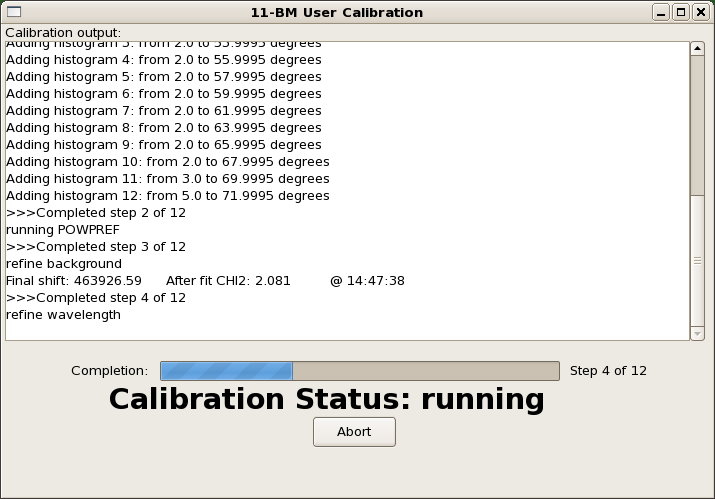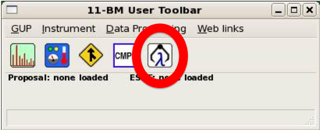Difference between revisions of "Calibration"
| Line 8: | Line 8: | ||
Collection of a new calibration scan and file is recommended after optimizing the monochromator, and required after the monochromator wavelength is altered. | Collection of a new calibration scan and file is recommended after optimizing the monochromator, and required after the monochromator wavelength is altered. | ||
=== Calibration Scan Parameters === | === Calibration Scan Parameters === | ||
| Line 19: | Line 18: | ||
*count time: 0.01 sec/step | *count time: 0.01 sec/step | ||
=== Generating Calibration Files === | === Generating Calibration Files === | ||
| Line 39: | Line 37: | ||
If for some reason the calibration fails, the program will notify users of the failed refinement. Check to make sure you have selected the correct scan and have used appropriate scan parameters. Suggested scan parameters are given above. Contact 11-BM staff is you continue to have problems. | If for some reason the calibration fails, the program will notify users of the failed refinement. Check to make sure you have selected the correct scan and have used appropriate scan parameters. Suggested scan parameters are given above. Contact 11-BM staff is you continue to have problems. | ||
Revision as of 23:47, 23 June 2010
About 11-BM Calibrations
A calibration file is needed to merge data collected from each of 11-BM's 12 detectors into a single intensity vs 2theta intensity dataset.
The calibration file corrects the 2theta zero shift, wavelength, and scaling factor for each of the 12 detectors.
Calibration files are obtained from a 12-histogram GSAS refinement of data collected on a standard powder sample. The standard powder sample is a mixture of NIST SRM 676a Al2O3 (~75 wt%) & SRM 640d Si (~25 wt%).
Collection of a new calibration scan and file is recommended after optimizing the monochromator, and required after the monochromator wavelength is altered.
Calibration Scan Parameters
At 30 keV - the standard calibration scan parameters currently are as follows:
- 2theta start: -17 deg
- 2theta end: 50 deg
- step size: 0.0005 deg
- count time: 0.01 sec/step
Generating Calibration Files
On-site users can create a new calibration file based on any scan of the standard Si2O3/Si powder sample.
Launch the calibration process by clicking the toolbar icon circled below, or select 'Calibrate' from the Data Processing Menu.
When prompted, select the file number of the scan which has been collected on the standard Si2O3/Si powder sample. Note - if the user has only collected a single scan for the active session, the software assumes this is a scan of the standard Si2O3/Si powder sample.
A full calibration refinement takes ~ 30 minutes. This process runs in the background and users can proceed with other tasks before the calibration is finished.
The calibration program gives updates on the progress of the refinement.

Upon the successful completion of a calibration refinement, the program will generate a calibration file and place a copy of this file in the users active GUP work directory.
If for some reason the calibration fails, the program will notify users of the failed refinement. Check to make sure you have selected the correct scan and have used appropriate scan parameters. Suggested scan parameters are given above. Contact 11-BM staff is you continue to have problems.
